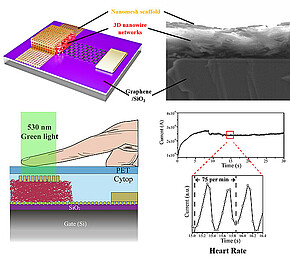Publication date: 16/07/21
ThemesNews
An organic photodetector that is extremely sensitive in the visible and near-infrared range has been developed by researchers at the Nanochemistry Laboratory of the Institute of Supramolecular Science and Engineering, in collaboration with Tsinghua University and Shenzhen University (China). A first application of this has been produced in the field of health monitoring. This new technology is of particular interest in numerous fields such as motion detection, water and food quality control, biomedical imagery and health and environmental monitoring. The results have recently appeared in the journal Nature Communications.
The researchers in Strasbourg, Beijing and Shenzhen developed a vertical phototransistor consisting of a continuous network of supramolecularly engineered perylene nanowires sandwiched between a graphene bottom electrode and a gold top electrode. The trick is not to use a continuous layer of gold for the top electrode, but a network of nanogrids, giving the gold electrode the appearance of a “punch card”, which provides better contact with the nanogrids and greater transparency due to the presence of nanoholes. This unique architecture results in excellent electrical and optoelectronic properties, in particular an ultra-sensitivity in the spectral range (from the visible to the near infrared), thus outperforming the devices based on complex organic materials that are commonly used for NIR light detection.
As proof of concept, the researchers built a sensor that can measure a patient’s heart rate in real time. This is achieved by using a green light source that passes through the fingertip, which is placed on the phototransistor, which in turn measures the transmitted light. Due to the variation in blood volume with each heart cycle, the patient’s pulse is derived from the current measured in the phototransistor.
These results represent a major advance in next-generation ultra-sensitive near-infrared photodetectors and offer potential for applications in a variety of fields.
















